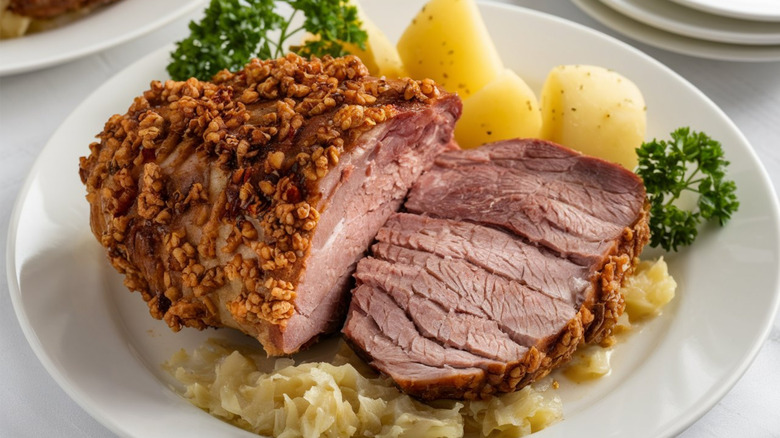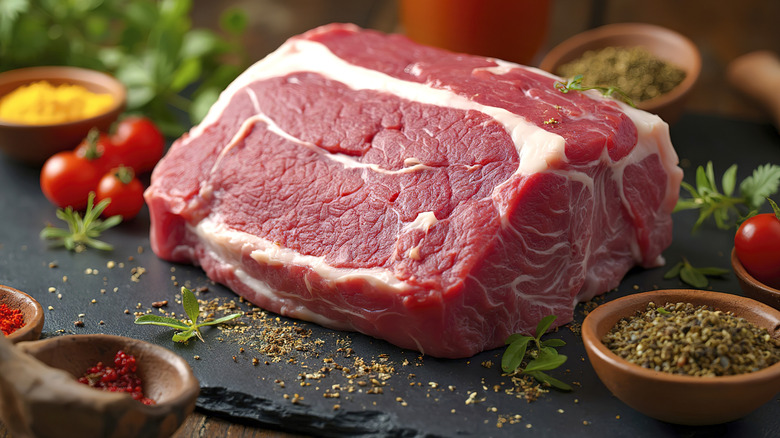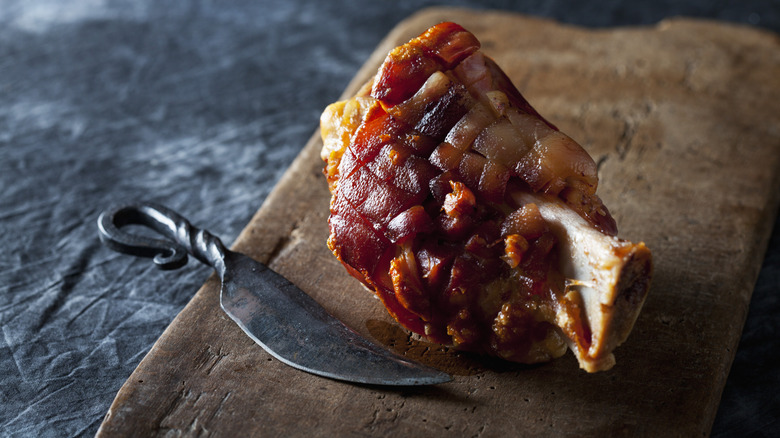The Best Cut To Use For Slow Cooker Pork And Sauerkraut
The cut of pork you choose for slow cooker pork and sauerkraut, which can be made with red cabbage for a vibrant dish, will be dependent on a couple of factors. While cuts like pork tenderloin continue to find favor with those making this classic German dish (and for good reason), you don't necessarily have to do what's always been done. Instead, you should look at the qualities of different cuts of pork and decide what you want the final result of your efforts to be. Once you do, you're better able to decide which one is right for the task at hand.
Given how many pork and sauerkraut recipes call for pork tenderloin (compared to pork loin, a larger, slightly fattier cut), it's logical to start your search with that. Tenderloin is popular for a couple of reasons. First, it's more tender than some cuts of pork, so if you're more pressed for time, it's your friend in the kitchen. It cooks in the slow cooker in just four hours, even if the cooker is set to low. If you set the machine to high, you cut down the cooking time by nearly half, bringing it down to about two and a half hours, give or take. Second, while it can get dry during cooking if you're not careful, this isn't all bad. Tenderloin is inclined to be a bit porous. This means that it drinks in the tangy flavors of sauerkraut more readily than some other cuts. This offers you more complexity of flavor, with both the taste of the pork and the flavor of the sauerkraut shining through in each bite.
Making the dish with tougher cuts of pork
If you're interested in trying out a tougher cut of pork or can't find tenderloin in a pinch, you're not out of luck — your dish will still turn out delicious. Pork butt, with its patterns of fat marbling and abundance of connective tissue, can be a tough cut, but is still great for this dish. It's the epitome of meat that thrives with a low-and-slow cooking method. The good news is, the factors that make it tough — the connective tissue and fat content — are also why it's so delicious and moist after spending hours in a Crock-Pot. As the meat cooks, the collagen in the connective tissue begins to break down, leaving you with pork that's juicy and flavorful. The fat and connective tissue soften over the six to 10 hours that it'll be in the slow cooker.
Pork chops, if taken from the rib area of the animal, are another tough cut of pork with a great deal of connective tissue. However, you're probably not going to find as much in this cut as you will in some others. This means you can put pork chops in the slow cooker on high for only four or five hours, though they take up to eight hours if cooked on low. For those looking for less fatty options for pork and sauerkraut, either because of preference or for health reasons, pork chops offer a good alternative to pork butt. It's also easy to find in the supermarket, which gives you a lot of flexibility when planning your grocery shopping.
Smoky-flavored cuts to consider
If you're a fan of meat that tastes smoky, there are a couple of cuts of pork that bring that extra dimension of flavor to the table and pair nicely with the rich umami-and-tangy flavor you crave in a pork and sauerkraut recipe: the pork ribs and the ham hocks. Both cuts work well with the low-and-slow cooking style of a Crock-Pot, so you won't need to worry about making a classic mistake with your pork dish by picking one.
Pork ribs are the cut to choose if your recipe calls for the pork to be braised before it's tossed in the slow cooker. Braising allows you to make use of the Maillard reaction, because this method asks you to sear the meat on the stove until it turns brown. The taste of this cut is already delicious, even without the braising, but if a complex flavor profile is your overarching goal when making pork and sauerkraut, you may want to experiment with pork ribs for this recipe.
Ham hocks, also sometimes referred to as pork knuckles, come from the spot on the pig's leg that's between the ankles and feet. This cut benefits from slow cooking as well. It isn't very meaty, which means you may have to combine cuts for your dish or use more than one ham hock to ensure that you have enough food to serve your family or guests. However, the trade-off is a smoky-flavored meal that rivals the stuff you find at Oktoberfest celebrations — no international travel is required. You just need a bit of time and a fork to get the full benefit of this flavor-packed version of pork and sauerkraut.


